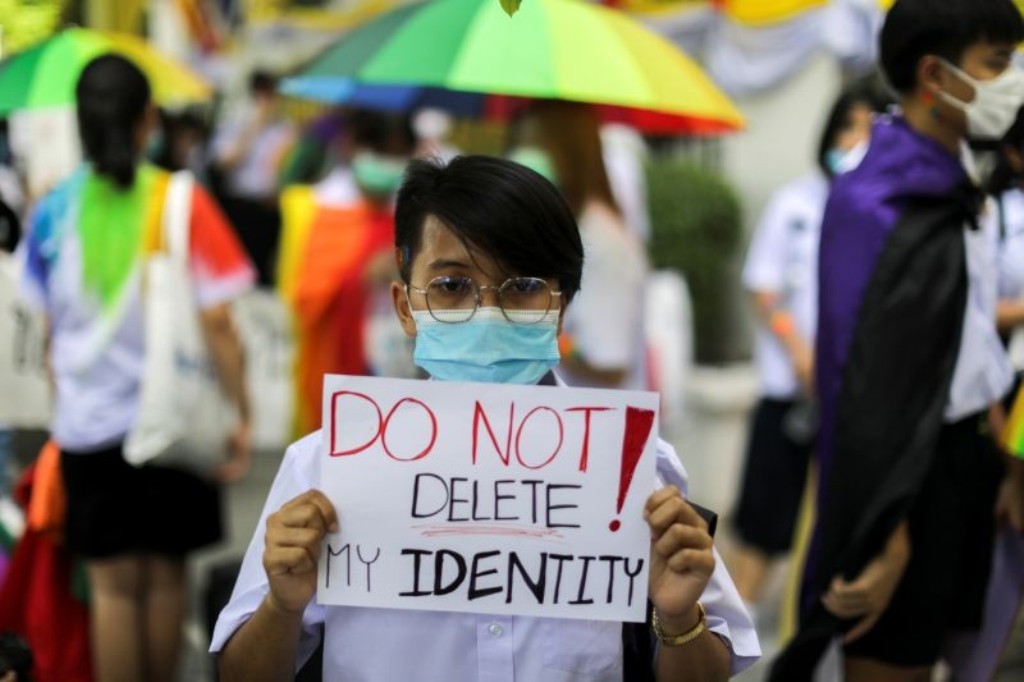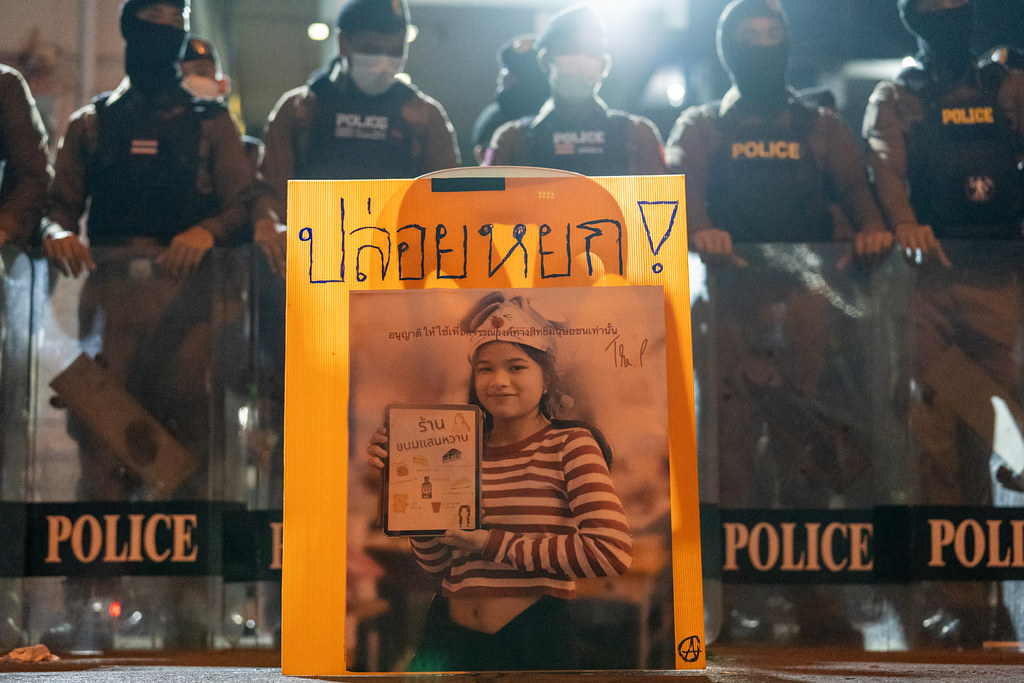When 15-year-old Thanalop “Yok” Phalanchai’s anti-uniform protest began in June, she became the centre of public attention throughout Thailand. Attending classes in casual clothes, many hailing her opposition to Thailand’s mandatory school uniform requirements as signalling a positive transition in society, while others saw it as premature activism.
Not long after her disobedience made news, Triam Udom Suksa Pattanakarn School in Bangkok’s Suan Luang district refused to enroll her to complete her high school education, citing her parents’ refusal to complete the registration process.
Despite the fact that the Ministerial Regulations on Student Registration 1992 provide that licensed guardians are valid stand-ins to complete the registration process, this occurred. Yok’s public reception may have been impacted by the fact that she was arrested and charged under Section 112 of the Criminal Code, or the royal defamation statute.
Yok was apprehended on March 28, the same day a 24-year-old guy was found spray-painting a “No 112” statement on the Temple of the Emerald Buddha’s wall.
Police stated they have a warrant to arrest the teenager, who is accused of insulting the monarchy during a gathering in front of Bangkok City Hall in October 2022. She was 14 years old at the time.
She was freed on May 18 after spending 51 days at the Ban Pranee Juvenile Vocational Training Centre for Girls in Nakhon Pathom last year.
“No one was killed as a result of my activism.” It was a significant gesture. It was the school personnel who barred me from attending classes because of my casual attire. This demonstrates that educational institutions and some of my countrymen are eager to bury anyone who pushes for social reform.”
Yok made these comments on her Facebook page on June 17 in reaction to widespread criticism of her anti-uniform position from netizens.
Authoritarianism in schools
Netiwit Chotiphatphaisal, 26, a fellow activist who has challenged many societal standards since he was in high school more than ten years ago, told the Bangkok Post that society is viewing Yok’s activism through a different lens than it used to.
“I believe society is rallying around Yok more. It was unusual to have supporters who were vociferous about my activities back then. Only independent news outlets such as Prachatai reported on my activities. Yok has been featured on national television and in major media outlets,” Mr Netiwit explained.
Mr Netiwit himself has advocated for an end to the stringent implementation of uniform and haircut regulations for students.
He believes that schools and universities should be open spaces where students can try new things. Even if Yok’s anti-uniform attitude fails on both practical and ideological grounds, it should not be such a big concern if the school serves as an experimental ground.
But, above and beyond the uniform and hairstyle debates, Mr Netiwit believes the actual issue is authoritarianism in the school system.
“We must delve deeply into the origins of such authoritarian rules.” They were started by an authoritarian regime that was opposed to both socialism and democracy. “School uniform and hairstyle rules are only the tip of the iceberg of a deep-seated authoritarianism,” he explained.
The military administration led by Field Marshal Thanom Kittikachorn first implemented hairstyle rules in 1972.
The guidelines were issued in the first Education Ministerial Regulation, which stated that male students’ hair could not be longer than five cm and female students’ hair could not be longer than the earlobes. Students are also not permitted to wear makeup to school.
After 51 years, most public schools have relaxed their rigorous haircut standards. Female students may grow their hair longer, but they are not permitted to wear it down while in school. Male students are permitted to develop fringe, but their sides must be kept short.
However, coloured or permed hair, as well as moustaches or beards, are strictly forbidden. Students who disobey such guidelines will face consequences such as forced hair trims or grade penalties.
Increased student participation in Thailand
Yok’s case has been investigated by the Ministries of Education, Social Development and Human Security, and Triam Udom Suksa Pattanakarn School as a clash between a 15-year-old student and far more experienced and authoritative people.
Many people, according to Ticha Na Nakorn, an adviser to the Children, Youth, and Family Foundation, saw Yok as a danger to school establishment. She did not, however, explicitly oppose the regulations.
“Some rules have been in place for quite some time. If we want to make changes, why not solicit input from the students?” Ms Ticha stated.
She proposed that public schools engage discussions with teachers, students, and parents about hairstyle and uniform restrictions. The sense of engagement will make participants feel like they are a part of the institution, which should help to moderate disagreements about the rules.
Ms Ticha stated that the public education system pushes children to be engaged citizens while simultaneously forcing them to be meek, a concept frequently lauded in schools.
“These Gen-Z students are uneasy with adult instruction.” “It’s a different time, and their demands are changing as well,” she explained.
Charged with royal defamation
However, Yok’s case is exceptional in that she was charged with royal defamation, a claim that has sparked popular outrage. “If Yok had just been a teenage girl who wanted a makeover like most girls her age,” Ms Ticha added, “teachers would have simply warned her not to break the rules.”
Yok was viewed as a threat to national security after being charged with lese majeste. This may have resulted in her being denied entry to school, which Ms Ticha felt was unjustified.
Sunai Phasuk, Human Rights Watch’s Thailand representative, stated on June 29 that Yok had been permitted to attend school in casual clothing and with dyed hair.
However, some teachers reportedly refused to assess her coursework, and the school is unable to grant her a diploma because she did not complete the registration process.
According to Mr Sunai, a committee made up of the Ministry of Social Development and Human Security, the Department of Children and Youth, Triam Udom Suksa Pattanakarn School, and its Parent-Teacher Association has yet to provide any updates on Yok’s student status.
School Dress Code Thailand
the dress code in Thailand schools typically requires students to wear uniforms. However, it’s important to note that dress codes may vary from one school to another and can be influenced by cultural and regional factors. Here’s a general overview of the school dress code in Thailand:
- Uniforms: Most Thai schools have specific uniforms for both boys and girls. These uniforms often consist of a collared shirt and a pair of trousers or a skirt. The colors and styles of the uniforms may differ depending on the school and educational level.
- Colors: The uniform colors usually represent the school’s identity and can vary. Common colors for school uniforms in Thailand include white, blue, and brown, but this can differ from school to school.
- Accessories: Students may be allowed to accessorize their uniforms within certain guidelines. For example, girls might wear ribbons or hair bands that match the uniform color, and boys might wear ties or belts.
- Shoes: Schools often have specific requirements for footwear. Students may be required to wear black or white shoes that are clean and polished. Some schools may have restrictions on the style of shoes, such as no sneakers or sandals.
- Hair: Students are typically expected to keep their hair well-groomed and neat. Boys are often required to have short hair, while girls may have more flexibility in terms of length but are usually expected to tie their hair back with matching accessories.
It’s worth noting that the dress code in Thailand can vary between public and private schools, as well as between different regions of the country. It’s always best to check with the specific school for their dress code guidelines to ensure compliance. Please keep in mind that my information might not be up to date, so it’s recommended to consult the latest sources or contact the school directly for the most accurate and current information.
⚠ Article Disclaimer
The above article is sponsored content any opinions expressed in this article are those of the author and not necessarily reflect the views of CTN News








